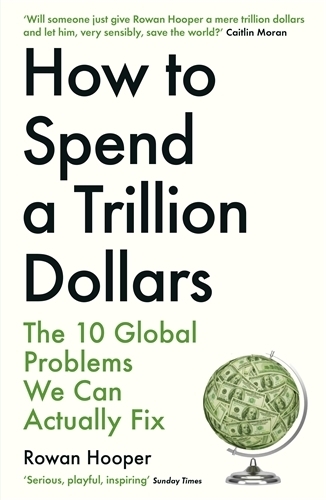
How to Spend a Trillion Dollars: The 10 Global Problems We Can Actually Fix
(Paperback, Main)
Publishing Details
How to Spend a Trillion Dollars: The 10 Global Problems We Can Actually Fix
By (Author) Rowan Hooper
Profile Books Ltd
Profile Books Ltd
1st March 2022
6th January 2022
Main
United Kingdom
Classifications
Tertiary Education
Non Fiction
Infectious and contagious diseases
Poverty and precarity
Rainforest
Left-of-centre democratic ideologies and movements
Space exploration
Charities, voluntary services and philanthropy
500
Physical Properties
Paperback
320
Width 128mm, Height 196mm, Spine 26mm
254g
Description
If you had a trillion dollars and a year to spend it for the good of the world and the advancement of science, what would you do It's an unimaginably large sum, yet it's only around one per cent of world GDP, and about the valuation of Google, Microsoft or Amazon. It's a much smaller sum than the world found to bail out its banks in 2008 or deal with Covid-19.
But what could you achieve with $1 trillion
You could solve the problem of the pandemic, for one, and eradicate malaria, and maybe cure all disease. You could end global poverty. You could settle on the Moon and explore the solar system. You could build a massive particle collider to probe the nature of reality like never before. You could build quantum computers, develop artificial intelligence, or increase human lifespan. You could even create a new life form.
Or how about transitioning the world to clean energy Or preserving the rainforests, or saving all endangered species Maybe you could refreeze the melting Arctic, launch a new sustainable agricultural revolution, and reverse climate change
How to Spend a Trillion Dollars is the ultimate thought experiment but it is also a call to arms: these are all things we could do, if we put our minds to it - and our money.
Reviews
'How To Spend a Trillion Dollars is both original and ingenious. Rowan Hooper looks at the problems facing the world today - all the big ones - and presents solutions that are realistic and workable, if governments can wring the money out of giant corporations - and billionaires - that don't like paying tax. Hooper writes with great vivacity and persuasiveness and his book is an exhilarating, encouraging, and hopeful reminder that the solutions are there if we have the will to find them. I hope it sells a trillion.' - Philip Pullman
'Will someone iust give Rowan Hooper a mere trillion dollars and let him, very sensibly, save the world' - Caitlin Moran
'ln a world of doom-scrolling, trembling on the brink of causing a mass extinction event that will devastate civilisation, it's crucially important to point out that we already have the abilities needed not only to avoid catastrophe, but to thrive. That's what Hooper does in fascinating and exciting detail.' - Kim Stanley Robinson
'At a moment when science is proving it can solve the most urgent of problems - given the right funding - Rowan Hooper asks a very interesting question. How much would it cost to solve all the world's other problems ... Like any good game, this is deadly serious. What starts off seeming absurd ends up feeling obvious. Why would we not invest in our future As Hooper says, "The world is full of extraordinary opportunities, and the vast majority are never undertaken"' - James McConnachie
'What would you do with a trillion dollars In this hopeful and very readable book, Rowan Hooper shows us how a thoughtful investment of financial capital could be used to solve the great challenges we face. None is more near and dire than the climate crisis, and Hooper provides reason for optimism here. The solutions-green energy chief among them-already exist. It's simply a matter of us investing in them. And a trillion dollars spent on climate solutions would payback several times over in avoided damage and destruction and new jobs. Read this book and be inspired to change the world.' - Michael Mann
Author Bio
Rowan Hooper is a senior editor at New Scientist magazine and host of the New Scientist Weekly podcast. After gaining a PhD in evolutionary biology, he moved to Japan and worked in a conservation biology lab, then a national newspaper in Tokyo, then Trinity College Dublin in a nanophysics lab. He is the author of Superhuman: life at the Extremes of Mental and Physical Ability. His work has been published in the Guardian, Washington Post, Wall Street Journal, Wired and The Economist.
He lives in London with his partner and two daughters.
